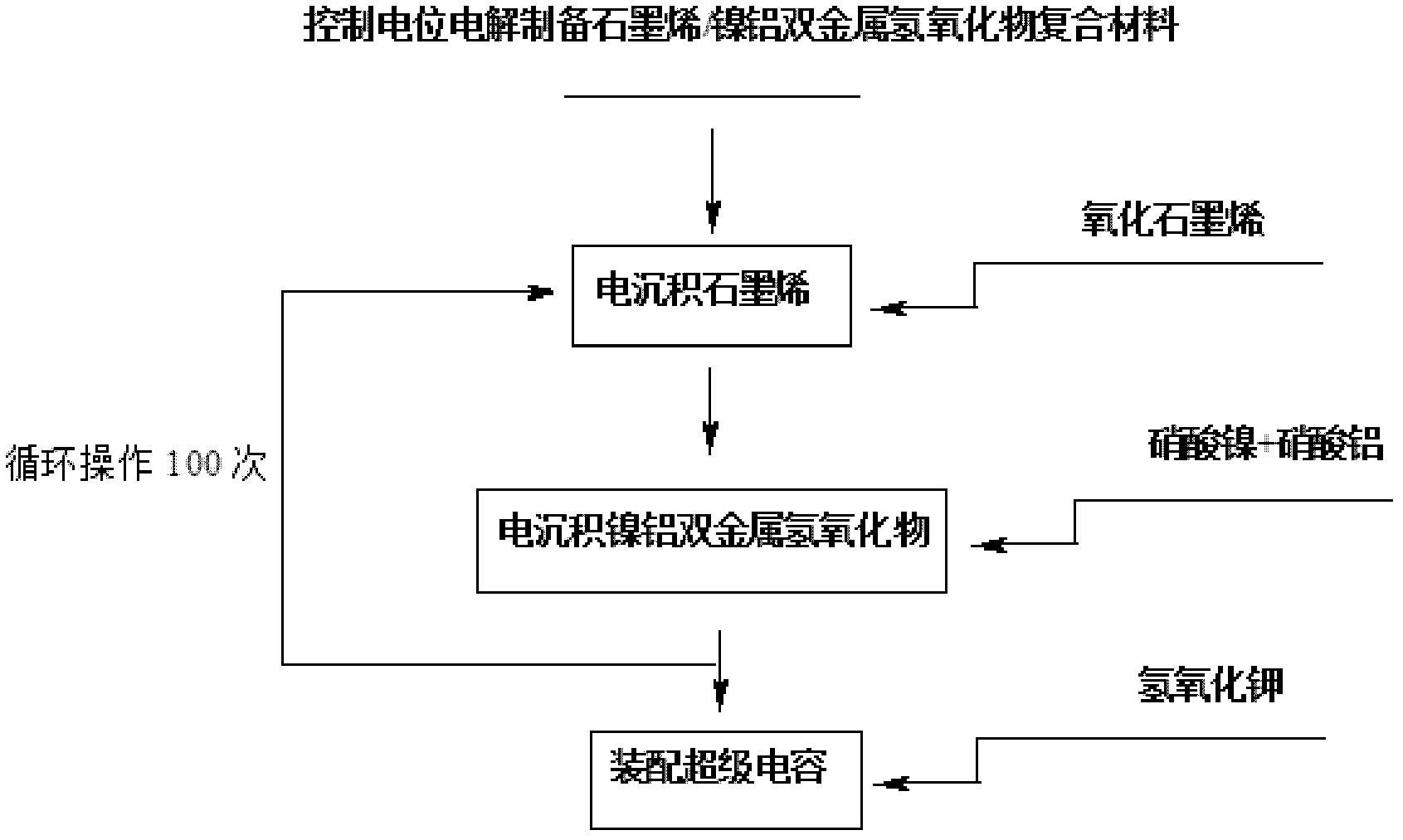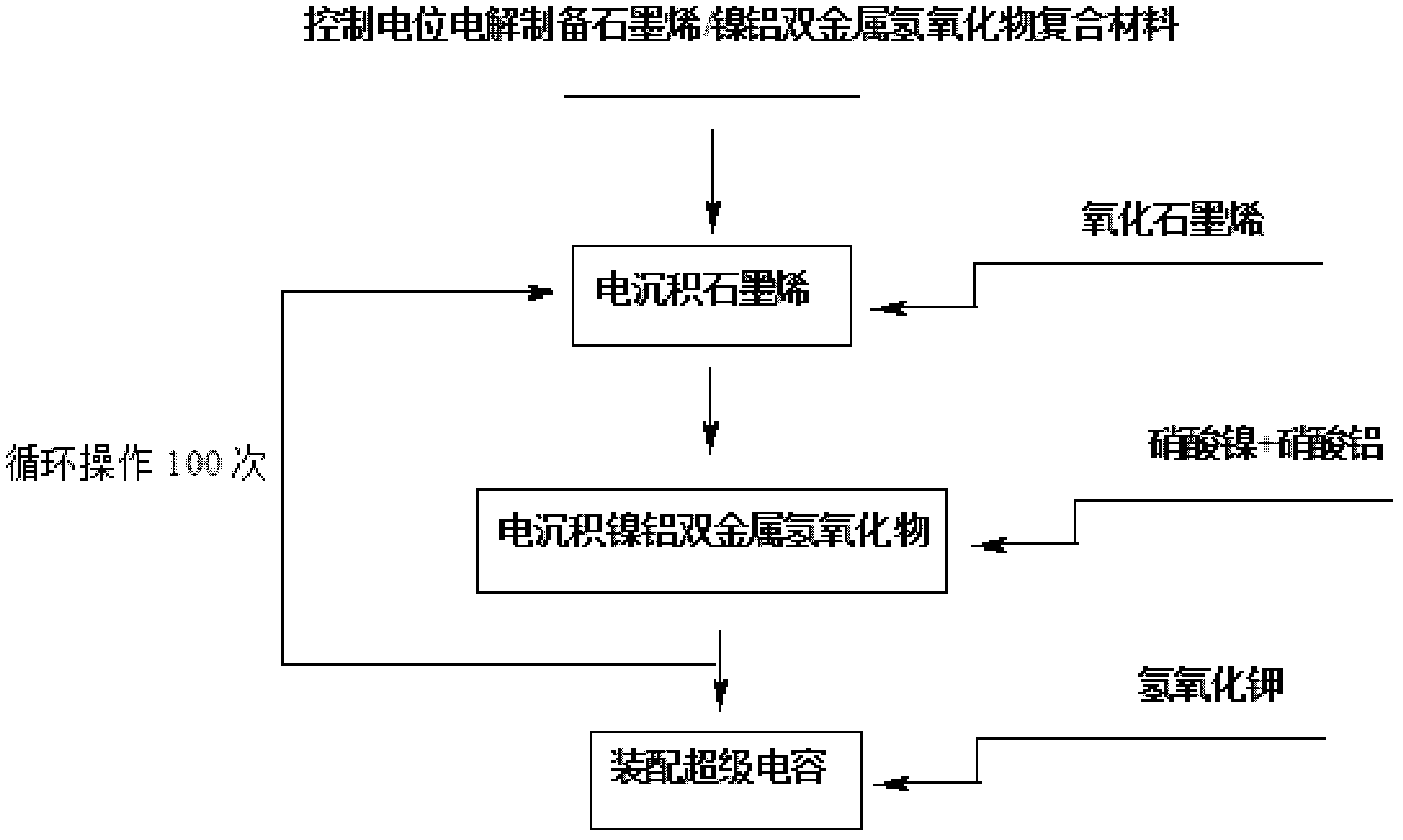Electrochemical preparation method of graphene/nickel-aluminum bimetal hydroxide composite material for super capacitor
A hydroxide and composite material technology, applied in capacitors, electrolytic capacitors, circuits, etc., can solve the problems of serious graphene agglomeration, poor dispersion of composite materials, environmental pollution, etc., and achieve good reproducibility, obvious capacitance, and improved Conductive effect
- Summary
- Abstract
- Description
- Claims
- Application Information
AI Technical Summary
Problems solved by technology
Method used
Image
Examples
Embodiment 1
[0024]Put 10mg of graphite oxide into a beaker, add 100mL of deionized water and 1.2g of potassium nitrate, ultrasonically oscillate for 10 minutes, select a potential value of -0.9V, and perform constant potential electrolysis at a temperature of 0°C for 10 seconds, take out the electrode, and wash it with deionized water ,dry. Put the prepared graphene-modified electrode into an electrolytic cell containing 0.002mol / L nickel nitrate, 0.01mol / L aluminum nitrate and 0.01mol / L sodium sulfate. Potential electrolysis for 10 seconds, take out the electrode, wash with deionized water, and dry. Repeat the electrodeposition operation 100 times, use the obtained graphene / nickel-aluminum double metal hydroxide composite as the working electrode and the counter electrode, and use 6.0mol / L potassium hydroxide solution as the electrolyte to assemble a supercapacitor with a capacitance of 1510F / g, after charging and discharging 1000 times, the capacity remains 99.5%.
Embodiment 2
[0026] Put 10mg of graphite oxide into a beaker, add 200mL of deionized water and 2.0g of sodium carbonate, ultrasonically oscillate for 20 minutes, select a potential value of -1.0V, and perform constant potential electrolysis at a temperature of 5°C for 20 seconds, take out the electrode and wash it with deionized water ,dry. Put the prepared graphene-modified electrode into an electrolytic cell containing 0.05mol / L nickel nitrate, 0.2mol / L aluminum nitrate and 0.02mol / L sodium chloride, select the potential value of -1.2V and the temperature at 0°C Electrolyze at constant potential for 10 seconds, take out the electrodes, wash with deionized water, and dry. Repeat the electrodeposition operation 100 times, use the obtained graphene / nickel-aluminum double metal hydroxide composite as the working electrode and the counter electrode, and use 5.0mol / L potassium hydroxide as the electrolyte to assemble a supercapacitor with a capacitance of 1950F / g. After charging and discharg...
Embodiment 3
[0028] Put 10mg of graphite oxide into a beaker, add 200mL of deionized water, oscillate ultrasonically for 20 minutes, select the potential value of -0.9V, and perform constant potential electrolysis at 0°C for 10 seconds, take out the electrode, wash it with deionized water, and dry it. Put the prepared graphene-modified electrode into an electrolytic cell containing 0.01mol / L nickel acetate, 0.01mol / L aluminum acetate and 0.06mol / L sodium sulfate. Potential electrolysis for 20 seconds, take out the electrode, wash with deionized water, and dry. Repeat the electrodeposition operation 100 times, use the obtained graphene / nickel-aluminum double metal hydroxide composite material as the working electrode and counter electrode, and 1.0mol / L potassium hydroxide solution as the electrolyte to assemble a supercapacitor with a capacitance of 1710F / g, after charging and discharging 1000 times, the capacity remains 99.9%.
PUM
 Login to View More
Login to View More Abstract
Description
Claims
Application Information
 Login to View More
Login to View More - R&D
- Intellectual Property
- Life Sciences
- Materials
- Tech Scout
- Unparalleled Data Quality
- Higher Quality Content
- 60% Fewer Hallucinations
Browse by: Latest US Patents, China's latest patents, Technical Efficacy Thesaurus, Application Domain, Technology Topic, Popular Technical Reports.
© 2025 PatSnap. All rights reserved.Legal|Privacy policy|Modern Slavery Act Transparency Statement|Sitemap|About US| Contact US: help@patsnap.com


